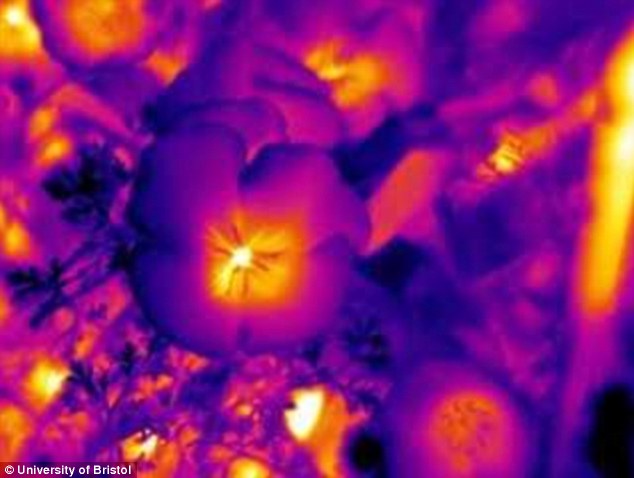Researchers have revealed the stunning patterns of invisible heat that attract bees to different flowers.
Bees are known to rely on a number of signals to choose where they’re going to land, from colors and smells to electric fields.
According to a new study, temperature differences across the petals may also play a critical role, serving as ‘sensory signposts’ to draw in the pollinators.
The study led by scientists from the University of Bristol found that flowers produce different heat patterns, which mimic the colors we can see.
Remarkable images of the floral heat patterns show how these vary among different kinds of flowers, with differing hotspots at the centers of rock rose, daisies, and poppies, for example.
In the study, the team found that the heat pockets are generally about 4-5 degrees Celsius hotter than the rest of the flower.
But, in some cases, they could be as much as 11 degrees warmer.
The researchers found that such floral heat patterns were present in the majority of the flowers they studied.
To better understand the role of these patterns, the team created artificial flowers that mimicked these heat patterns.

The artificial flowers, however, did not have the corresponding color patterns seen in their real-life counterparts.
To human eyes, the team explains, the artificial flowers would look identical.
The researchers say these patterns can help bees to distinguish different flowers, and convey information on the rewards they provide.
But, the experts warn the changing climate could soon affect these interactions.
‘The presence of multiple cues on flowers is known to enhance the ability of bees to forage efficiently, so maximising the amount of food they can take back to sustain the rest of their colony,’ said lead author Dr Heather Whitney, from the university’s School of Biological Sciences.

‘Climate change might have additional previously unexpected impacts on bee-flower interactions by disrupting these hidden heat patterns.’

Recent research on bees has uncovered details on their remarkable navigation skills, shedding light on how these pollinators find their way to and from the hive.
In a study led by the University of Edinburgh, researchers discovered the neurons that detect speed and direction to help guide bees home.
The neurons are located in a part of the insect brain called the central complex.
Scientists found this region plays a pivotal role in controlling the navigation system – known as path integration or ‘dead reckoning’, which is used by many animals, including bees, ants and humans.












